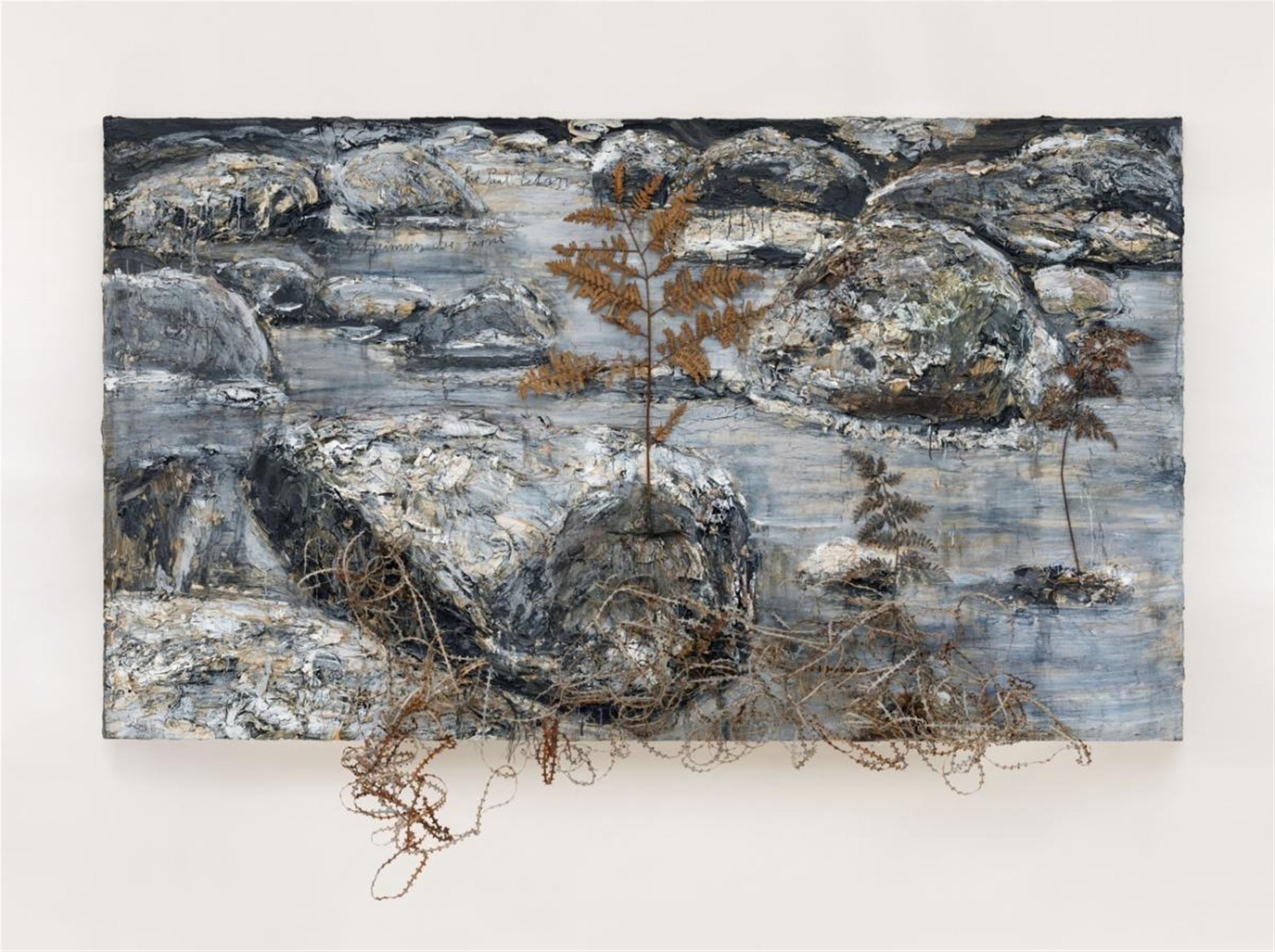Anselm Kiefer
Geheimnis der Farne
1996-2000
Oil, emulsion, acrylic, chalk, branches, resin coated fern, plaster, shellac, clay, barb wire on canvas. Approx. 190 x 330 cm.
Anselm Kiefer's works are 'works of remembrance' revealing the intellectual analysis of his personal as well as national past, of Jewish mysticism, of alchemistic traditions and of ancient myths (cf. lot 523). As a result, Kiefer's works categorically exude a mysterious and often sublime aura which is substantiated in its monumentality on the one hand and its diversity of interpretation on the other hand. In the present work, Kiefer layers various primeval-appearing materials above and below each other and thus creates a mysterious-looking swamp scene before the eyes of the beholder in which several boulders - wreathed with ferns and a conglomerate of barbed wire at the lower margin - rise up from a riverbed. The key to decrypting this mysterious scene is provided by Kiefer's typical inscriptions in the upper left-hand area of the painting: 'für Paul Celan' [for Paul Celan] and 'Geheimnis der Farne' [Secret of the Ferns]. Paul Celan, one of the most significant poets of the 20th century, is one of the most important sources of reference in Kiefer's complete works as can be ascertained with reference to a multitude of his works. A prominent example is the poem 'Death Fugue' which concerned Kiefer thematically in several works. The application of poppy-seeds can also be traced back to Paul Celan. With the present work 'Geheimnis der Farne' [Secret of the Ferns] Kiefer refers back to Celan's poem of the same name which he had written during his occupation as an editor and translator in Bucharest in 1946:
'In the vault of swords the leaf-green heart of shadows looks at itself.
The blades are bright: who would not linger in death before mirrors?
Also in jugs here a sadness that's living is drunk to:
Flowery it darkens up, before they drink, as though it were not water,
As though here it were a daisy of which darker love is demanded,
A pillow more black for the couch, and heavier hair…
But here there is only dread for the shining of iron;
And if anything here still glints up, may it be a sword.
Were not mirrors our hosts, never we'd empty the jug from this table:
Let one of them crack and split where we're green as the leaves.'
(Poems of Paul Celan: A Bilingual German/English Edition, Revised Edition, translated by Michael Hamburger, New York 2001)
Kiefer succeeds in transforming the enigmatic magic of Celan's language into his art. Moreover, analogous to Cordula Meier's reflections in her Kiefer monograph, an ambiguity typical of Kiefer can be ascertained that points beyond the obvious: 'Kiefer's panel painting develops as a palimpsest structure through the successive application of various materials. At the same time, these materials already possess an evident aesthetic quality of their own due to their pure materiality. Earth, sand, straw, ashes - to name only the materials of an organic category - have a graphic power. Besides this described materiality which, among other things, severely dominates the colour and surface quality of the paintings, these materials used by Kiefer also always emerge in the painting as a substance charged with meaning or […] the material only then pertains its polysemic meaning as part of the overall work.' (Cordula Meier, Anselm Kiefer, Die Rückkehr des Mythos in der Kunst, Essen 2013, p.148). The title-giving fern is the material of ambiguous content within the present work. Thus, in the exhibition catalogue of 2012, Dieter Ronte points out the mystical meaning of the 'witchweeds' which can be which can be traced to numerous examples in literary and cultural history: '[It] is meant to offer protection against witches and magic as well as make people invisible. As it says in Shakespeare's Henry IV:” We have the receipt of fern seed; we walk invisible.” In 1612, the council of Ferrara issued a ban on collecting fern seeds on St John's Eve (summer solstice), as the fern only blooms on this night. The German name for one type of fern is therefore Wünschelfarn (Wish Fern). Wood ferns prevented back ache because of their shape (Doctrine of Signatures, natura naturans, Paracelsus). The German saying about the common polypody claims that it “make brides sweet and mild, so that they do not bicker”. Hildegard von Bingen called the fern scourge of the devil and evil spirits. The fern was also meant to keep bad weather at bay and bring luck in love and gaming. However, the secret lies precisely in the fern seeds: they reproduce using spores. This mystery was first brought to light in the mid-nineteenth century by the Leipzig-based botanist Wilhelm Hofmeister (1824-1877).' (Dieter Ronte, In Bildern denken, Thinking in Pictures, in: Beate Reifenscheid (ed.), Anselm Kiefer, Memorabilia, exhib.cat. Ludwig Museum im Deutschherrenhaus Koblenz, Milan 2012, p.56)
Provenance
Private collection, Hesse
Exhibitions
Shanghai 2014 (China Art Museum), Wild Heart, Art Exhibition of German Neo-Expressionism since the 1960s
Koblenz 2012 (Ludwig Museum im Deutschherrenhaus), Anselm Kiefer, Memorabilia, exhib.cat., pp.82/83 with colour illus.

